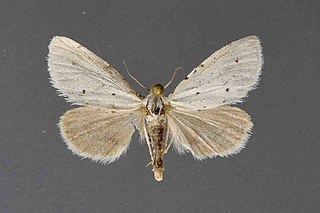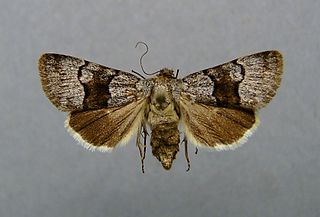Related Research Articles

Xestia is a genus of noctuid moths. They are the type genus of the tribe Xestiini in subfamily Noctuinae, though some authors merge this tribe with the Noctuini. Species in this genus are commonly known as "clays", "darts" or "rustics", but such names are commonplace among Noctuidae. Xestia moths have a wide distribution, though they most prominently occur in the Holarctic.
Afotella is a monotypic moth genus of the family Noctuidae erected by William Barnes and Foster Hendrickson Benjamin in 1926. Its only species, Afotella cylindrica, was first described by Augustus Radcliffe Grote in 1880. It is found in western North America from Saskatchewan and Alberta south to California.
Airamia is a monotypic moth genus of the family Noctuidae. Its only species, Airamia albiocula, is known from the US state of California. Both the genus and species were first described by William Barnes and Foster Hendrickson Benjamin, the genus in 1926 and the species in 1918.
Anycteola is a monotypic moth genus of the family Noctuidae erected by William Barnes and Foster Hendrickson Benjamin in 1929. Its only species, Anycteola fotelloides, was first described by Barnes and James Halliday McDunnough in 1916. It is found in the US state of Arizona.

Euxoa is a genus of moths of the family Noctuidae raised to Genus by the German entomologist, Jacob Hübner. The Genus is mostly confined to dry and semi dry areas in the Northern Hemisphere. There 130 species in Eurasia, a few in Africa, and 175 in North America. There are no species in the Genus in South-East Asia or in Australia. In North America, most species are found in Western regions. Of the North American species, 4 are endemic to Mexico. There is one species recorded from Chile, but this may be a mislabeled specimen. In real terms, species numbers do not equal species abundance. Some areas with few species have large numbers of the ones that do live there.
Eviridemas is a monotypic moth genus of the family Noctuidae erected by William Barnes and Foster Hendrickson Benjamin in 1929. Its only species, Eviridemas minuta, was first described by Barnes and James Halliday McDunnough in 1910.

Grotellaforma is a monotypic moth genus of the family Noctuidae erected by William Barnes and Foster Hendrickson Benjamin in 1922. Its only species, Grotellaforma lactea, was first described by Stretch in 1885. It is found in North America, including California and Arizona, its type locations.
Heminocloa is a monotypic moth genus of the family Noctuidae erected by William Barnes and Foster Hendrickson Benjamin in 1924. Its only species, Heminocloa mirabilis, was first described by Berthold Neumoegen in 1884. It is found in the US state of Arizona.
Hemioslaria is a monotypic moth genus of the family Noctuidae. Its only species, Hemioslaria pima, is known from the US state of Arizona. Both the genus and species were first described by William Barnes and Foster Hendrickson Benjamin in 1924.
Lemmeria is a monotypic moth genus of the family Noctuidae erected by William Barnes and Foster Hendrickson Benjamin in 1926. Its only species, Lemmeria digitalis, was first described by Augustus Radcliffe Grote in 1882. It is found in the US state of Maine.
Neotarache is a monotypic moth genus of the family Noctuidae. Its only species, Neotarache deserticola, is found in the US state of Nevada. Both the genus and species were first described by William Barnes and Foster Hendrickson Benjamin in 1922.

Plagiomimicus is a genus of moths of the family Noctuidae. The genus was erected by Augustus Radcliffe Grote in 1873.
Properigea is a genus of moths of the family Noctuidae. The genus was erected by William Barnes and Foster Hendrickson Benjamin in 1926.
Sexserrata is a monotypic moth genus of the family Noctuidae. Its only species, Sexserrata hampsoni, is found in the US state of California. Both the genus and species were first described by William Barnes and Foster Hendrickson Benjamin in 1922.

Sympistis is a genus of moths of the family Noctuidae. The genus was erected by Jacob Hübner in 1823.
Homoanarta is a genus of moths of the family Noctuidae erected by William Barnes and Foster Hendrickson Benjamin in 1923.

Grotella harveyi is a species of moth in the genus Grotella, of the family Noctuidae. This moth species is found in North America, including Colorado, its type location.

Grotella stretchi is a species of moth in the genus Grotella, of the family Noctuidae. This moth species was first described by William Barnes and Foster Hendrickson Benjamin in 1922. It is found in North America, including California, its type location.
Lasionycta poca is a moth of the family Noctuidae first described by William Barnes and Foster Hendrickson Benjamin in 1923. It is found throughout the Rocky Mountains of Alberta, westward to the Coast Range in western British Columbia and southward in the Cascades to Okanogan County, Washington.
Lasionycta dolosa is a moth of the family Noctuidae first described by William Barnes and Foster Hendrickson Benjamin in 1923. It is found in the Rocky Mountains of Colorado.
References
- ↑ Savela, Markku. "Engelhardtia Barnes & Benjamin, 1923". Lepidoptera and Some Other Life Forms. Retrieved June 10, 2019.
- Pitkin, Brian & Jenkins, Paul. "Search results Family: Noctuidae". Butterflies and Moths of the World. Natural History Museum, London.